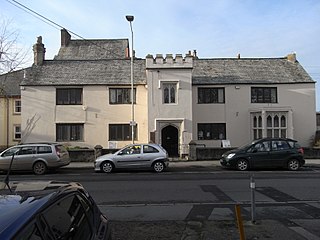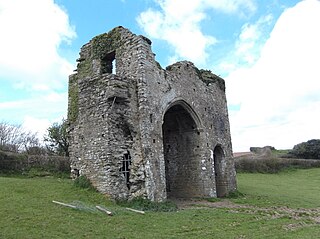
Totnes is a market town and civil parish at the head of the estuary of the River Dart in Devon, England within the South Devon Area of Outstanding Natural Beauty. It is about 21 miles (34 km) south-southwest of Exeter and is the administrative centre of the South Hams District Council.

Bridgetown occupies the left bank of the Dart in the town of Totnes, Devon, England.

Broadhempston is a village, parish and former manor in Devon, situated about 4 miles north of Totnes. It is now administered by Teignbridge District Council. According to the 2001 census the parish contained 257 houses with a population of 641.
Juhel de Totnes, Latinised to Judhellus filius Aluredi, "Juhel son of Alured") was a soldier and supporter of William the Conqueror (1066-1087). He was the first Anglo-Norman feudal baron of Totnes and feudal baron of Barnstaple, both in Devon.
SS Rosehill – also known as SS Penhill – was a 2,788-tonne steel-hulled collier built in 1911 by S.P. Austin and Son of Sunderland under the name Minster. She was torpedoed by the Imperial German Navy submarine U-40 in the English Channel off Fowey, Cornwall, England, on 23 September 1917 while en route from Cardiff, Wales, to Devonport. She was taken under tow but sank in Whitsand Bay at 18:05. Her wreck lies in 28 metres of water at 50°19.793′N4°18.520′W with her bow to the north.

Carisbrooke Priory was an alien priory, a dependency of Lyre Abbey in Normandy. The priory was situated on rising ground on the outskirts of Carisbrooke close to Newport on the Isle of Wight.

Totnes Museum is a local museum in the town of Totnes, south Devon, in southwest England.

Totnes Guildhall is a Grade I listed 16th-century Tudor historic guildhall, magistrate's court, and prison, in the town of Totnes, south Devon, in southwest England.
Donnington Friary was a friary of crouched friars at Donnington in the English county of Berkshire. At the time of suppression the establishment was recorded as Trinitarian, but this was later corrected to Crossed Friars. This was possibly a ploy by the two brothers in occupation at the time in order to ensure their pension.

The Priory of St Mary Magdalene in Barnstaple was a priory in Devon, England. It was founded in about 1107 by Juhel de Totnes, feudal baron of Barnstaple, who had earlier founded Totnes Priory in about 1087 at the caput of his former feudal barony of Totnes, from which he had been expelled. Barnstaple Priory was of the Cluniac order, and was senior to all others of that order in England. It was dedicated to St Mary Magdalene. It was situated on land outside the town walls stretching from the North Gate to the East Gate with the River Yeo forming its northern boundary. Nearby to the north across the River Yeo was the Benedictine Pilton Priory of St Mary the Virgin, a cell of Malmesbury Abbey, founded slightly later, between 1107 and 1199.

Cornworthy Priory was a priory in Devon, England. It was founded in the early thirteenth century, for Augustinian nuns, and existed until 1536. At the Dissolution of the Monasteries the lands passed to the Harris family, and remained in the family until the 1640s. Thomas Harris who was a Serjeant-at-Law lived here with his wife Elizabeth. Their daughter, Anne, Lady Southwell, who was a noted poet, was born here.
Otterton Priory was a priory in Devon, England.
Totnes Priory was a priory at Totnes in south Devon, England.
Frampton Priory was a priory in Dorset, England.
Wareham Priory was a monastery in Dorset, England, possibly founded by the Saxons in 672 and dispersed during the Danish raids on Wareham in 876. It was refounded in 915 by Elfleda and probably dissolved in 998.
Ellingham Priory was a medieval monastic house in Ellingham, Hampshire, England. It was founded by William de Soleres in 1160. It was a cell to the Abbey of Saint-Sauveur-le-Vicomte in Normandy. The church of Ellingham formed part of the grant of William de Solers to Ellingham Priory.
Moatenden Priory was a priory located at Headcorn,about six miles south of Maidstone in Kent, England.

The Devonshire Collection of Period Costume is a collection of historic costumes housed in the Totnes Fashion and Textiles Museum in the town of Totnes, south Devon, in southwest England.












